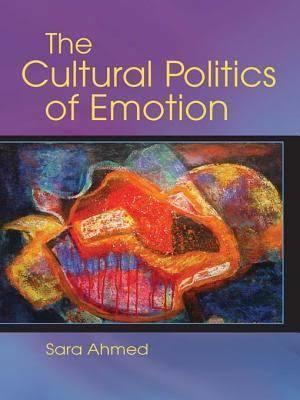8.6 /10 1 Votes8.6
Originally published 2004 | 4.3/5 Goodreads | |||||||||||||||||||||||||||||||||
 | ||||||||||||||||||||||||||||||||||
Similar Works by Sara Ahmed, Emotion books | ||||||||||||||||||||||||||||||||||
The Cultural Politics of Emotion, published in 2004 by Edinburgh University Press and Routledge, is a book by Sara Ahmed that focuses on the relationship between emotions, language, and bodies. Ahmed concentrates on the influence of emotions on the body and the way that bodies relate with communities, producing social relationships that determine the rhetoric of the nation. The book contributes to the growing conversation about emotion in rhetoric and cultural studies and employs a variety of theories including rhetorical theory, queer theory, feminist theory, Marxist theory, and poststructuralist theory of language.
Contents
Summary of Ahmed's hypothesis
Ahmed argues emotions are cultural practices, not psychological states. Bodies are given value through emotion and thus the bodies, as well as the individuals, become aligned with a popular ideology. Cultural politics of emotions creates "others" by aligning some bodies with each other inside a community and marginalizing other bodies. The repetition of words, or more broadly signs, elicits an emotional response that only grows upon more repetition. Words often generate meaning because of their history and context, but eventually they can take on a new meaning. Emotions are material rhetoric - they have affective power and can dictate our modes of life. In fact, they are gateways into the social and material world. Emotions can lead to collective politics and social alliances; this social power is exhibited through politics and social movement, even to create national identities. To illustrate her points, Ahmed analyzes public texts and the figurative language that they employ to name or perform emotion. Ahmed's theory encourages readers to consider the political implications of emotion.
Contents
Ahmed's book centers around three political events and ideas: the reconciliation of Australian aboriginal children to their families, the public's response to international terrorism, and asylum and immigration in the United Kingdom. She analyzes texts surrounding these concepts to demonstrate how emotions are public and how the public is emotive.
The book is broken down into the following chapters:
- The Contingency of Pain: Discusses the way that pain is used in politics to demand action or shape identities
- The Organisation of Hate: Discusses the role of hate in nation building to separate self from others
- The Affective Politics of Fear: Argues that responses to terrorism work as an economy of fear
- The Performativity of Disgust: Emphasizes the way that the public views the "other" with disgust
- Shame Before Others: Asserts that shame can form a collective ideal and work for nation building
- In the Name of Love: Discusses the way that multicultural love can help build a nation's identity
- Queer Feelings: Considers the importance of emotions in queer theory
- Feminist Attachments: Discusses the role of emotions in feminist theory
